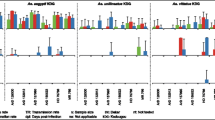Abstract
Ingwavuma virus (INGV), a mosquito-borne arbovirus reported from Africa and Southeast Asia has been found circulating in India as evidenced by virus isolation and antibody prevalence. INGV is now classified as Manzanilla orthobunyavirus belonging to family Peribunyaviridae. The virus is maintained in nature in a pig-mosquito-bird cycle. Human infection has been confirmed by virus isolation and detection of neutralizing antibodies. A study was initiated to determine the vector competence of Aedes aegypti, Culex quinquefasciatus, and Cx tritaeniorhynchus mosquitoes to INGV due to their high prevalence in India. Mosquitoes were oral fed on viraemic mice and INGV dissemination to legs, wings, salivary glands (saliva) was studied alongwith virus growth kinetics. The three mosquitoes replicated INGV with maximum titers of 3.7, 3.7 and 4.7log10TCID50/ml respectively and maintained the virus till 16th day post infection. However, vector competence and horizontal transmission to infant mouse was demonstrated only by Cx quinquefasciatus mosquitoes. Vertical or trans-ovarial transmission of INGV could not be demonstrated in the mosquito during the study. Though no major outbreak involving humans has been reported yet, the potential of the virus to replicate in different species of mosquitoes and vertebrates including humans pose a threat to public health should there be a change in its genome.


Similar content being viewed by others
References
McIntosh BM, McGillivray GM, Dickinson DB. Ingwavuma virus: an arbovirus isolated in South Africa. S Afr J Med Sci. 1965;30(3):67–70.
Causey OR, Kemp GE, Causey CE, Lee VH. Isolations of Simbu-group viruses in Ibadan, Nigeria 1964–69, including the new types Sango, Shamonda, Sabo and Shuni. Ann Trop Med Parasitol. 1972;66(3):357–62.
Top FH Jr, Kraivapan C, Grossman RA, Rozmiarek H, Edelman R, Gould DJ. Ingwavuma virus in Thailand: infection of domestic pigs. Am J Trop Med Hyg. 1974;23:251–7.
Converse JD, Tan RI, Rachman IT, Lee VH, Shope RE. Ingwavuma virus (Simbu group) from Culex and Mansonia mosquitoes (Diptera: Culicidae) in Indonesia. J Med Entomol. 1985;22:339–42.
Fagbami AH, Fabiyi A. Arbovirus studies in two towns in western state of Nigeria. J Trop Geogr Med. 1975;27(1):59–62.
Fagbami A. Human arthropod-borne virus infections in Nigeria. Serological and virological investigations and Shaki, Oyo State. J Hyg Epidemiol Microbiol Immunol. 1978;22:184–9.
Pavri KM, Sheikh BH, Singh KRP, Rajagopalan PK, Casals J. Balagodu virus, a new arbovirus isolated from Ardeola grayii (Sykes) in Mysore state, South India. Indian J Med Res. 1969;57:758–64.
Ladner JT, Savji N, Lofts L, et al. Genomic and phylogenetic characterization of viruses included in the Manzanilla and Oropouche species complexes of the genus Orthobunyavirus, family Bunyaviridae. J Gen Virol. 2014;95(5):1055–66. https://doi.org/10.1099/vir.0.061309-0.
Whitmer SLM, Yadav PD, Sarkale P, et al. Characterization of unknown orthobunya-like viruses from India. Viruses. 2018;10(9):451. https://doi.org/10.3390/v10090451.
Sudeep AB, Shaikh N, Ghodke YS, Ingale VS, Gokhale MD. Vector competence of certain Culex and Aedes mosquitoes for the Chittoor virus, the Indian variant of the Batai virus. Can J Microbiol. 2018;64(8):581–8. https://doi.org/10.1139/cjm-2017-0514.
Reed LJ, Muench HA. A simple method for estimating fifty percent endpoint. Am J Hyg. 1938;27:493–7.
Marano G, Pupella S, Vaglio S, Liumbruno GM, Grazzini G. Zika virus and the never-ending story of emerging pathogens and transfusion medicine. Blood Transfus. 2016;14(2):95–100. https://doi.org/10.2450/2015.0066-15. (Epub 2015 Nov 5).
Weaver SC, Lecuit M. Chikungunya virus and the global spread of a mosquito-borne disease. N Engl J Med. 2015;372(13):1231–9. https://doi.org/10.1056/NEJMra1406035.
Weaver SC, Charlier C, Vasilakis N, Lecuit M. Zika, Chikungunya, and other emerging vector-borne viral diseases. Ann Rev Med. 2018;69:395–408. https://doi.org/10.1146/annurev-med-050715-105122.
Samaan Z, Vaz MS, Bawor M, Potter TH, Eskandarian S, Loeb M. Neuropsychological impact of West Nile virus infection: an extensive neuropsychiatric assessment of 49 Cases in Canada. PLoS ONE. 2016;11(6):e0158364. https://doi.org/10.1371/journal.pone.0158364.
Mehta R, Gerardin P, de Brito CAA, Soares CN, Ferreira MLB, Solomon T. The neurological complications of chikungunya virus: a systematic review. Rev Med Virol. 2018;28(3):e1978. https://doi.org/10.1002/rmv.1978.
Papa A. Emerging arboviruses of medical importance in the Mediterranean region. J Clin Virol. 2019;115:5–10. https://doi.org/10.1016/j.jcv.2019.03.007.
Sorvillo TE, Rodriguez SE, Hudson P, Carey M, Rodriguez LL, Spiropoulou CF, et al. Towards a sustainable one health approach to Crimean-Congo hemorrhagic fever prevention: focus areas and gaps in knowledge. Trop Med Infect Dis. 2020;5(3):E113. https://doi.org/10.3390/tropicalmed5030113.
Sudeep AB, Gurav YK, Bondre VP. Changing clinical scenario in Chandipura virus infection. Indian J Med Res. 2016;143(6):712–21.
Musso D, Gubler DJ. Zika virus. Clin Microbiol Rev. 2016;29(3):487–524. https://doi.org/10.1128/CMR.00072-15.
Ferraris P, Yssel H, Missé D. Zika virus infection: an update. Microbes Infect. 2019;21(8–9):353–60. https://doi.org/10.1016/j.micinf.2019.04.005.
Sudeep AB, Jadi RS, Mishra AC. Ganjam virus. Indian J Med Res. 2009;130(5):514–9.
Sudeep AB, Ghodke YS, George RP, Ingale VS, Dhaigude SD, Gokhale MD. Vectorial capacity of Culex gelidus (Theobald) mosquitoes to certain viruses of public health importance in India. J Vector Borne Dis. 2015;52(2):153–8.
Wilson WC, Gaudreault NN, Hossain MM, McVey DS. Lesser-known bunyavirus infections. Rev Sci Tech. 2015;34(2):419–29. https://doi.org/10.20506/rst.34.2.2368.
Acknowledgements
The authors thank Prof. Priya Abraham, Director, ICMR- National Institute of Virology, Pune for her constant support and encouragement. The authors also thank Mrs Triparna Majumdar for technical support in the molecular work.
Author information
Authors and Affiliations
Corresponding author
Ethics declarations
Conflicts of interest
The authors declare no conflicts of interest.
Additional information
Publisher's Note
Springer Nature remains neutral with regard to jurisdictional claims in published maps and institutional affiliations.
Rights and permissions
Springer Nature or its licensor (e.g. a society or other partner) holds exclusive rights to this article under a publishing agreement with the author(s) or other rightsholder(s); author self-archiving of the accepted manuscript version of this article is solely governed by the terms of such publishing agreement and applicable law.
About this article
Cite this article
Kumar, S., Sreelekshmi, P.R., Godke, Y.S. et al. Vector competence of three species of mosquitoes to Ingwavuma virus (Manzanilla orthobunyavirus), a new bunyavirus found circulating in India. VirusDis. 34, 15–20 (2023). https://doi.org/10.1007/s13337-023-00808-z
Received:
Accepted:
Published:
Issue Date:
DOI: https://doi.org/10.1007/s13337-023-00808-z




